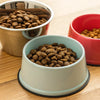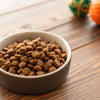What is Dry Dog Food Called? Understanding Kibble and Its Benefits
- Houndsy
Table of Contents
- Introduction
- What is Kibble?
- What is the Difference Between Kibble and Dry Dog Food?
- Benefits of Kibble Dog Food
- Kibble Food for Puppies
- Kibble Food for Adult Dogs
- Kibble Food for Working Dogs
- Kibble and Your Dog's Lifestyle
- Conclusion
Introduction
Have you ever wondered what that crunchy, dry dog food in your pet's bowl is actually called? If your furry friend has a penchant for wagging their tail at the mere mention of “kibble,” you're not alone! Kibble, a term pet owners are increasingly familiar with, represents more than just dry dog food; it’s a staple that many of us rely on to nourish our beloved companions.
In recent years, the popularity of kibble has surged, with pet owners gravitating towards this convenient and nutritious option. But what exactly does kibble entail, and how does it differ from other types of dog food? In this blog post, we will delve into the world of dry dog food, exploring the definition of kibble, its nutritional benefits, and why it remains a top choice among pet parents.
By the end of this article, you'll have a comprehensive understanding of what dry dog food is called, the intricacies of kibble, and how to select the best options for your four-legged family member. So, let’s embark on this journey to elevate our dog feeding experiences together!
What is Kibble?
Kibble is a term used to describe dry dog food that is typically shaped into small, bite-sized pieces or pellets. It is made from a combination of ingredients, including meat, grains, vegetables, and various nutritional supplements. The name "kibble" itself is derived from a now-uncommon verb meaning "to grind or chop coarsely," which aptly describes the process of creating these crunchy morsels.
Kibble is crafted through a method called extrusion, where the ingredients are mixed, cooked, and then shaped into the familiar pellet form. This process ensures that kibble is shelf-stable, easy to store, and convenient for pet owners to serve. It’s important to note that while kibble is often synonymous with dry dog food, the quality and nutritional value can vary significantly from one brand to another.
The Nutritional Composition of Kibble
High-quality kibble is designed to provide a balanced diet for dogs of all life stages. It typically contains:
- Proteins: Essential for muscle development and overall health.
- Carbohydrates: Provide energy and aid in digestion.
- Fats: Important for skin and coat health, as well as energy.
- Vitamins and Minerals: Support various bodily functions and immune health.
When selecting kibble, it’s crucial to read the ingredient list and look for named protein sources, wholesome grains, and minimal fillers. This ensures that your dog receives the right nutrients for a healthy and active lifestyle.
What is the Difference Between Kibble and Dry Dog Food?
While the terms "kibble" and "dry dog food" are often used interchangeably, there are subtle distinctions worth noting. Kibble specifically refers to the small, pelletized form of dry dog food that is created through the extrusion process. In contrast, dry dog food can encompass a broader category that may include various types of dehydrated or baked formulas.
Key Differences
- Form: Kibble is specifically pelletized, while dry dog food can come in other forms, such as flakes or biscuits.
- Production Process: Kibble is typically produced using high-heat extrusion, whereas other dry dog foods might be baked or dehydrated at lower temperatures.
- Nutritional Profile: Kibble often contains added fats and flavorings after processing to enhance taste, whereas some dry food options may focus on natural ingredients without additional flavorings.
Understanding these differences can help pet owners make informed choices about the type of dry food they select for their dogs.
Benefits of Kibble Dog Food
Kibble offers numerous advantages, making it a popular choice for pet owners. Here are some of the key benefits:
Convenience
Kibble is incredibly easy to store, measure, and serve, making it a practical option for busy pet parents. It can be kept in bulk without worrying about spoilage, as it has a longer shelf life compared to wet dog food. For example, our flagship product, the Houndsy Kibble Dispenser, elevates the feeding experience by providing a convenient crank at standing height, allowing for easy portion control without bending down.
Balanced Nutrition
Many kibbles are formulated to meet the nutritional standards set by the Association of American Feed Control Officials (AAFCO). This means they provide a complete and balanced diet for dogs, with the right blend of proteins, fats, carbohydrates, vitamins, and minerals. This is essential for maintaining your dog’s overall health.
Dental Health Benefits
The texture of kibble can aid in dental hygiene. Chewing on kibble can help reduce plaque and tartar buildup, promoting healthier teeth and gums. While kibble should not replace regular dental care, it can be a helpful part of a pet's oral health routine.
Cost-Effectiveness
Kibble is often more affordable than wet dog food, making it an economical choice for pet owners. Buying in bulk can lead to additional savings, providing a nutritious diet without breaking the bank.
Less Messy
Compared to wet food, kibble is less messy and easier to clean up. It can be left out longer without the risk of bacterial contamination, making it a practical option for households with children or other pets.
Kibble Food for Puppies
When it comes to feeding puppies, kibble can be an excellent choice if you select the right formula. Puppies have unique nutritional needs as they grow and develop, requiring higher levels of protein and fat compared to adult dogs.
Transitioning to Kibble
Puppies can start being introduced to kibble around 7 to 8 weeks of age, often after beginning the weaning process from their mother's milk. It’s best to mix a small amount of kibble with wet food initially, gradually increasing the proportion of kibble over time. This approach helps ease the transition and allows puppies to adapt to the new texture.
Nutritional Considerations
When selecting kibble for puppies, look for formulas specifically labeled as "puppy food." These kibbles are designed to support healthy growth and development, often enriched with DHA for brain development and essential vitamins for immune support.
Kibble Food for Adult Dogs
For adult dogs, kibble remains a top choice due to its balanced nutrition and convenience. Adult dog kibble is typically formulated to maintain a healthy weight and support overall well-being.
Choosing the Right Adult Kibble
When selecting kibble for adult dogs, consider factors such as their size, activity level, and any specific dietary needs. For example, active dogs may benefit from higher protein content, while senior dogs might require formulas with joint support ingredients like glucosamine and chondroitin.
Kibble Food for Working Dogs
Working dogs, including service animals and those in active roles, have different nutritional requirements compared to sedentary pets. They require more energy-dense foods to support their intense activities.
Specialized Kibble Formulas
Some brands offer specialized kibble formulated for working dogs, often containing higher levels of protein and fat to meet their energy demands. These formulas help ensure that working dogs remain healthy and perform at their best.
Kibble and Your Dog's Lifestyle
Understanding your dog's lifestyle is crucial when selecting the right kibble. Factors such as age, breed, activity level, and health conditions should be considered to ensure that the chosen kibble meets their specific needs.
Assessing Lifestyle Needs
- Active Dogs: Require higher caloric intake and may benefit from high-protein formulas.
- Senior Dogs: Often need lower-calorie options with joint support.
- Sensitive Stomachs: Look for grain-free or limited-ingredient kibbles that are easier on digestion.
Conclusion
In summary, kibble is not just dry dog food; it represents a convenient, nutritious, and balanced option for dogs of all life stages. By understanding what dry dog food is called and the benefits it offers, we can make informed choices that enhance our pets' health and well-being.
At Houndsy, we are committed to elevating the dog feeding experience through innovative design and functionality. Our Houndsy Kibble Dispenser exemplifies our dedication to simplifying the feeding ritual while ensuring that your pet receives perfectly portioned meals every time.
As we continue to explore the world of pet nutrition, we encourage you to consider your dog's unique needs and lifestyle when selecting kibble. Together, we can create a healthier and happier feeding experience for our furry companions.
FAQ
What is kibble made of?
Kibble is typically made from a combination of meat, grains, vegetables, and added vitamins and minerals, all processed into small pellets.
Is kibble better than wet dog food?
Both kibble and wet dog food have their advantages. Kibble is often more convenient and cost-effective, while wet food can provide additional moisture and flavor.
How do I choose the right kibble for my dog?
Consider your dog's age, size, activity level, and any specific health needs. Look for high-quality ingredients and formulas designed for your dog's unique requirements.
Can I mix kibble with wet food?
Yes! Many pet owners choose to mix kibble with wet food to enhance flavor and texture, making mealtime more exciting for their dogs.
How much kibble should I feed my dog?
The amount of kibble to feed your dog depends on their size, age, and activity level. Always refer to the feeding guidelines on the kibble packaging and consult with your veterinarian for personalized recommendations.
We hope this information helps you understand what dry dog food is called and why kibble is a preferred option for many pet owners. Happy feeding!












